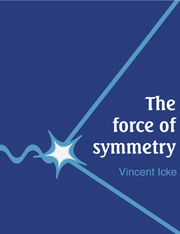Book contents
- Frontmatter
- Contents
- Preface
- Introduction
- 1 A matter of force
- 2 Stalking the wild rainbow
- 3 Light
- 4 Maybe I'm Heisenberg
- 5 Catch a falling quantum
- 6 Quantum beanbags
- 7 Symmetries
- 8 Quantum relativity: nothing is relative
- 9 Life, the Universe and everything
- 10 The physics of a tablecloth
- 11 Colour me red, green and blue
- 12 Smashing symmetry
- 13 How much is infinity minus infinity?
- 14 Excelsior! The ascent to SU(∞)
- A modest reading proposal
- References
- Glossary
- Index
8 - Quantum relativity: nothing is relative
Published online by Cambridge University Press: 05 August 2012
- Frontmatter
- Contents
- Preface
- Introduction
- 1 A matter of force
- 2 Stalking the wild rainbow
- 3 Light
- 4 Maybe I'm Heisenberg
- 5 Catch a falling quantum
- 6 Quantum beanbags
- 7 Symmetries
- 8 Quantum relativity: nothing is relative
- 9 Life, the Universe and everything
- 10 The physics of a tablecloth
- 11 Colour me red, green and blue
- 12 Smashing symmetry
- 13 How much is infinity minus infinity?
- 14 Excelsior! The ascent to SU(∞)
- A modest reading proposal
- References
- Glossary
- Index
Summary
Rotations in space-time
So far, I have discussed in detail two of the ingredients that govern the structure of our Universe: quantization and symmetry. Now we will consider the third, namely relativity. As it happens, relativity is actually associated with a symmetry, albeit a rather unusual one. Whether this is a coincidence or whether it indicates a deeper level of physical truth is not understood at present. As an introduction to the symmetry that produces relativity, let us return for a moment to rotations in space.
A symmetry group always leaves something unchanged; in the case of space rotations, the invariant is the distance between points. In three-dimensional space, we need three numbers (coordinates; say x, y and z) to describe the position of a point. The distance D is given by the Pythagoras recipe: D2 = x2 + y2 + z2. In a plane, two numbers (say x and y) suffice. Under rotations of the plane, D2 = x2 + y2 is an invariant.
Suppose that some sixteenth-century navigators in Amsterdam were to measure the latitudes and longitudes of two points on Earth, and from these calculate the distance between the points. Now let some Parisian navigators do the same. In olden times, people were every bit as chauvinistic about the location of their country as they are today, so naturally the Dutch used the meridian of Amsterdam, and the French used the Paris meridian for their observations.
- Type
- Chapter
- Information
- The Force of Symmetry , pp. 114 - 149Publisher: Cambridge University PressPrint publication year: 1995



